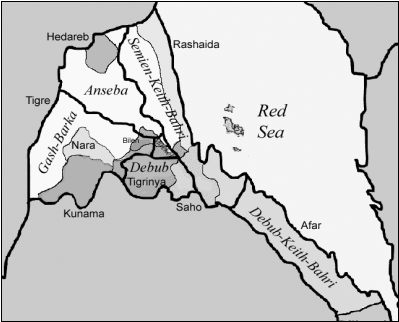Eritrean Educational System
 The
Minister of Education
for Eritrea, Osman Saleh, requested
that Math/Science Nucleus work on this project after visiting our training
facility in Fremont, California. He
was drawn by the long and
successful record of Math/Science Nucleus in curriculum development using
hands-on materials and integrating technology in the classroom as an
alternate to textbook-based instruction.
The Minister felt this combination of experience with innovative
curriculum and technology could benefit the future of Eritrea in educating
its children.
The
Minister of Education
for Eritrea, Osman Saleh, requested
that Math/Science Nucleus work on this project after visiting our training
facility in Fremont, California. He
was drawn by the long and
successful record of Math/Science Nucleus in curriculum development using
hands-on materials and integrating technology in the classroom as an
alternate to textbook-based instruction.
The Minister felt this combination of experience with innovative
curriculum and technology could benefit the future of Eritrea in educating
its children.
Eritrea achieved independence ten years ago in 1991, making it the newest independent country in Africa. It emerged from a 30-year liberation struggle with a strong commitment to building its educational system as an integral part of national development. During its struggle for independence, Eritrea’s founders distinguished themselves by having established and operated an educational system behind enemy lines.
Eritrea has six governmental Zobas with regional control over their educational system subject to guidelines from the Ministry of Education. Elementary schools are taught in their native language. Middle and secondary schools are taught in English. There are nine ethnic groups with their own languages. The shaded areas in the map show the location of these groups -- Tigre, Hadareb, Nara, Kunama, Rashaida, Tigrinya, Bilen, Saho, and Afar – in Eritrea.
Any country that is in recovery from war has problems to overcome. Eritrea has teacher shortages and lacks schools, especially in remote areas. Many schools lack electricity and water. The Eritrean government realizes that despite these limitations its children will need to compete in the global economy. The style of instruction in Eritrea is mainly teacher-centered with rote learning which is effective in producing literacy. It’s unlikely this method can produce competitive individuals that will remain in Eritrea to solve national problems. Internet technology and revised teaching materials can provide one of the best means for future Eritreans to be competitive in a global market
There are infrastructural limitations to be overcome in installing and realizing the potential in Internet technology. Eritrea lacks communication technologies nationwide within its educational infrastructure. In the cities, students have access to telephones and Internet and are exposed to these technologies. However in most schools in the other parts of the country, schools have neither. Few roads exist outside the urban centers, so school officials from the Zobas have to use off road vehicles and make visits only once or twice a semester.
2 Les Gottesman, To Fight And Learn: The Praxis and Promise of Literacy In Eritrea’s Independence War, 1998, Lawrenceville, NJ: The Red Sea Press, Inc.